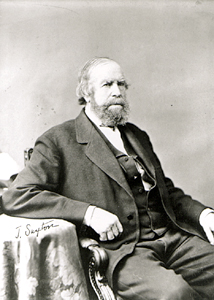Joseph Saxton
Joseph Saxton (born March 22, 1799 in Huntingdon , Pennsylvania , † October 26, 1873 in Washington, DC ) was an American watchmaker , inventor and instrument maker.
Saxton worked early in his father's nail factory, was essentially self-taught (even though he was an apprentice watchmaker in his hometown for two years) and worked as a watchmaker in Philadelphia . There he invented a machine that cut gears in the form of epicycloids for clocks. His reputation as an inventor earned him membership in the Franklin Institute in Philadelphia . In 1828 he went to London for further training , where he worked as an instrument maker at the Adelaide Gallery of Practical Science , which was newly founded in 1831 , an institution that publicly presented new scientific findings and devices and also presented magic tricks. He constructed devices for magic tricks, diving bells, large magnets and similar attractions. Saxton attracted a lot of attention and made the acquaintance of important British engineers and Michael Faraday , which also led to the construction of electrodynamic machines by Saxton. In 1837 he returned to Philadelphia and worked as an overseer of weights and measures at the United States Mint and, from 1843, in a similar position at the US Coast and Geodetic Survey in Washington DC. In this role, he was responsible for the standard weights and measures in the USA.
He was inducted into the National Inventors Hall of Fame and was a founding member of the National Academy of Sciences in 1863 and the American Philosophical Society (1837). In 1834 he received the Scott Medal from the Franklin Institute.
Web links
| personal data | |
|---|---|
| SURNAME | Saxton, Joseph |
| BRIEF DESCRIPTION | American watchmaker and instrument maker |
| DATE OF BIRTH | March 22, 1799 |
| PLACE OF BIRTH | Huntingdon , Pennsylvania |
| DATE OF DEATH | October 26, 1873 |
| Place of death | Washington, DC |
